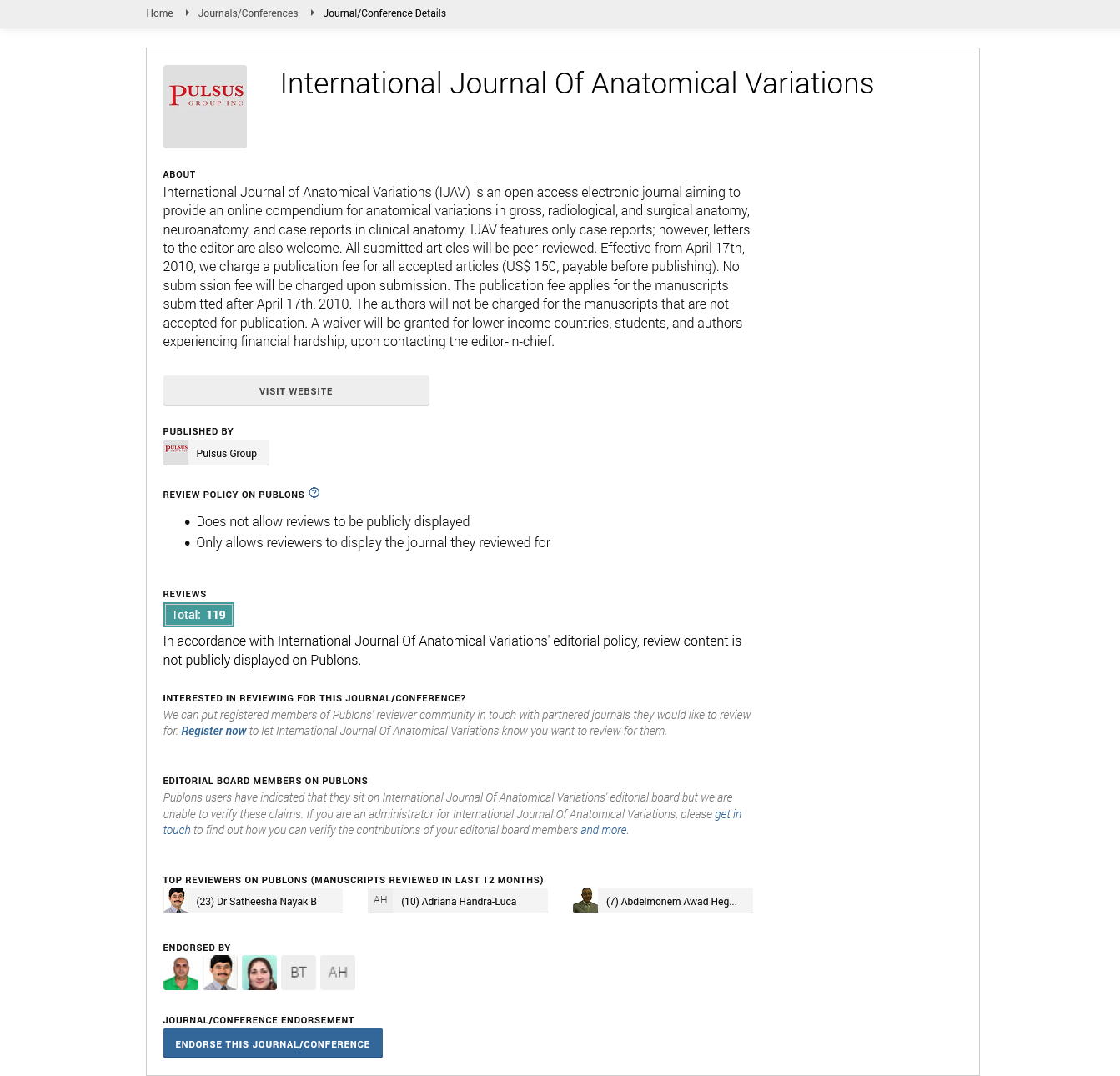Persistent Sciatic Artery: Embryological Development and Clinical Considerations in Vascular Surgery
Received: 02-Jan-2025, Manuscript No. ijav-25-7542; Editor assigned: 04-Jan-2025, Pre QC No. ijav-25-7542 (PQ); Reviewed: 18-Jan-2025 QC No. ijav-25-7542; Revised: 24-Jan-2025, Manuscript No. ijav-25-7542 (R); Published: 31-Jan-2025, DOI: 10.37532/1308-4038.18(1).474
Citation: Wojcik MK. Persistent Sciatic Artery Embryological Development and Clinical Considerations in Vascular Surgery. Int J Anat Var. 2025;18(1): 717-718.
This open-access article is distributed under the terms of the Creative Commons Attribution Non-Commercial License (CC BY-NC) (http://creativecommons.org/licenses/by-nc/4.0/), which permits reuse, distribution and reproduction of the article, provided that the original work is properly cited and the reuse is restricted to noncommercial purposes. For commercial reuse, contact reprints@pulsus.com
INTRODUCTION
The persistent sciatic artery (PSA) is a rare anatomical variant in which the sciatic artery, which is normally expected to regress during fetal development, fails to do so and remains patent into adulthood. This persistence can have significant clinical implications, especially in the fields of vascular and orthopedic surgery. The sciatic artery plays a crucial role during early fetal development, providing blood supply to the developing lower limb, but its function is typically taken over by the femoral artery later in gestation. When this regression does not occur, it results in the persistence of the sciatic artery, which can complicate surgical procedures due to its anatomical location and vascular connections. Understanding the embryological development of the sciatic artery, its persistence as an anatomical variant, and the clinical considerations surrounding its presence are essential for minimizing surgical risks and ensuring patient safety [1].
EMBRYOLOGICAL DEVELOPMENT OF THE SCIATIC ARTERY
During early fetal development, the sciatic artery serves as the primary blood supply to the lower limb. It arises from the dorsal branch of the internal iliac artery and travels through the pelvis, reaching the hind limb bud. This artery is critical for providing vascular support during the early stages of limb formation, as it facilitates the development of the lower extremities. The sciatic artery typically begins to regress during the second trimester of pregnancy, as the femoral artery assumes the primary role in supplying blood to the lower limbs. By the end of the second trimester regression of the sciatic artery does not occur completely, resulting in its persistence into adulthood. The cause of this failure to regress remains largely unknown, though it is considered an anomaly that can occur during the vascular remodeling process. This condition is rare, but its occurrence can lead to significant anatomical and clinical challenges, especially when it presents in a fully formed artery capable of providing substantial blood flow [2].
ANATOMICAL FEATURES OF THE PERSISTENT SCIATIC ARTERY
The persistent sciatic artery typically follows the course of the original fetal structure, passing through the sciatic notch and continuing along the posterior hip and thigh. In some cases, the artery may remain a small, vestigial vessel, with little to no functional role, while in other cases, it can be a more substantial structure. The artery may continue down the posterior thigh to the popliteal artery or serve as a secondary vessel in the lower limb. Its size and the extent to which it contributes to the vascularization of the leg vary among individuals, making it a highly variable anatomical feature. In cases where the PSA is well-developed, it can provide significant blood flow to the gluteal region, hip joint, and sometimes even the lower leg. Its proximity to vital structures such as the sciatic nerve and femoral nerve increases the risk of injury during surgical procedures in the pelvis and lower extremities. This abnormal vascular course can complicate surgeries that involve the posterior hip or thigh, such as hip replacements, femoral artery bypasses, and revascularization procedures [3].
CLINICAL IMPLICATIONS IN VASCULAR SURGERY
The presence of a persistent sciatic artery can have substantial implications for surgical planning and patient safety. Surgeons performing procedures in the pelvis, hip, or thigh must be aware of the possibility of a PSA to avoid inadvertent injury. The artery’s abnormal course, especially through the sciatic notch and close to the sciatic nerve, increases the risk of bleeding and vascular damage during surgeries. In particular, procedures such as total hip arthroplasty, hip fractures, femoral artery access, and vascular reconstructions carry a higher risk of accidental injury to the persistent artery. If the artery is damaged during dissection or surgery, it can lead to catastrophic hemorrhage, requiring immediate intervention to control bleeding and repair the vessel. Furthermore, the presence of the PSA can complicate endovascular procedures. For example, when performing angioplasty or stenting in the lower limbs, the persistent artery may be mistaken for the primary femoral or popliteal artery, leading to incorrect placement of devices or potential embolization. If embolization occurs, it can disrupt blood flow to the lower extremities, leading to ischemia and necessitating additional interventions to salvage the limb [4].
DIAGNOSTIC TECHNIQUES FOR IDENTIFYING THE PERSISTENT SCIATIC ARTERY
Accurate identification of the persistent sciatic artery is crucial to avoid complications during surgery or endovascular procedures. Diagnostic imaging plays a central role in detecting the PSA and mapping its course. Conventional angiography is the gold standard for visualizing the vascular anatomy, as it provides detailed information about the artery’s size, location, and relationship to surrounding structures. However, non-invasive imaging techniques such as CT angiography and magnetic resonance angiography (MRA) are increasingly being used due to their ability to offer high-resolution, three-dimensional views of the vascular network. These advanced imaging modalities allow surgeons to identify and plan for any anatomical variations, including the presence of the PSA, well before surgery begins. In some cases, ultrasonography can also assist in detecting the persistent sciatic artery, particularly when the artery is relatively large or well-developed. High-resolution ultrasound can provide real-time, dynamic imaging, allowing for the assessment of blood flow and the detection of any potential vascular abnormalities [5].
SURGICAL CONSIDERATIONS AND MANAGEMENT OF THE PERSISTENT SCIATIC ARTERY
The management of patients with a persistent sciatic artery involves careful surgical planning. Surgeons must account for the potential presence of this anomalous vessel during procedures in the pelvis, hip, and thigh. Preoperative imaging is essential to identify the location, size, and course of the PSA, which allows for safer dissection and minimizes the risk of inadvertent injury. When the PSA is detected, it may be necessary to adjust surgical approaches to avoid disturbing the artery. For instance, alternative incision sites or techniques may be required during hip arthroplasty or femoral artery bypass surgeries to bypass the vessel and prevent damage. If the PSA is inadvertently injured during surgery, prompt hemostasis is critical to control bleeding. In some cases, the artery may need to be ligated or embolized to prevent continued blood loss. In situations where the artery is contributing significantly to the vascular supply of the lower limb, additional steps may be necessary to revascularize the affected area.
CONCLUSION
The persistent sciatic artery is a rare but clinically significant anatomical variation that can complicate surgeries in the pelvis, hip, and lower extremities. Its embryological origins and failure to regress during fetal development can lead to vascular challenges during various surgical procedures. Surgeons must be aware of the potential presence of this anomaly, particularly when operating in areas where the artery may course through the sciatic notch or other critical regions. Through preoperative imaging, accurate identification of the PSA is possible, allowing for better surgical planning and minimizing the risk of complications. As our understanding of this variation deepens, it will be essential to continue researching the optimal management strategies for patients with persistent sciatic arteries, ensuring improved outcomes in clinical practice.
REFERENCES
- Rayt HS, Bown MJ, Lambert KV. Buttock claudication and erectile dysfunction after internal iliac artery embolization in patients prior to endovascular aortic aneurysm repair. Cardiovasc Intervent Radiol. 2008; 31(4):728-34.
- Nayak SB, Shetty P, Surendran S, Shetty SD. Duplication of Inferior Gluteal Artery and Course of Superior Gluteal Artery Through the Lumbosacral Trunk. OJHAS. 2017; 16.
- Osher M, Semaan D, Osher D. The uterine arteries, anatomic variation and the implications pertaining to uterine artery embolization. J Vasc Interv Radiol 2014; 25:S143.
- Albulescu D, Constantin C, Constantin C. Uterine artery emerging variants - angiographic aspects. Current Health Sciences Journal 2014; 40:214-216.
- Patel SD, Perera A, Law N, Mandumula S. A novel approach to the management of a ruptured Type II endoleak following endovascular repair of an internal iliac artery aneurysm. Br J Radiol. 2011; 84(1008):e240-2.
Indexed at, Google Scholar, Crossref
Indexed at, Google Scholar, Crossref
Indexed at, Google Scholar, Crossref






